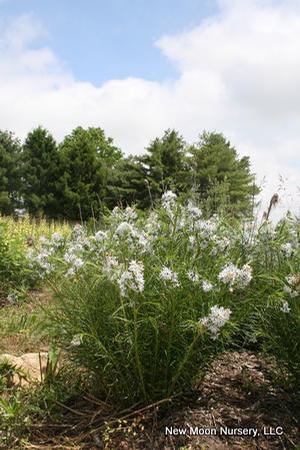New Moon Nurseries
Amsonia hubrichtii
Thread leafed bluestar
Native to North America
FIRST IMPRESSIONS: Threadleaf Bluestar (also known as Arkansas Amsonia or Hubricht’s Bluestar) has three solid seasons of interest in the garden. In its everyday demeanor, extremely fine textured linear foliage attracts the attention of passers-by. The unique texture has given rise to many comparisons. Some say it is like a conifer or an asparagus fern or a grass – difficult to describe but always eye-catching. In spring, typical starry blue blooms crown plants. And… perhaps the most showy golden foliage of all the Amsonias sparkles in the autumn light. As if that weren’t enough, it is ridiculously easy to grow.
HABITAT & HARDINESS: The plant was originally discovered in western Arkansas growing on a dry rocky slope in the Ouachita Mountain. According to the USDA it is native to 9 counties in Arkansas and to parts of Oklahoma. In its native habitat, plants occur on rocky outcrops and dry creek banks.
Threadleaf Bluestar has proven to be adapted to a wide variety of sites in USDA Zones 5-9. Plants are adaptable to sunny or partly sunny sites in most well drained soils.
PLANT DESCRIPTION: Threadleaf Bluestar is a sturdy warm season perennial with a broadly rounded growth habit. This form becomes shrub-like and more striking with age. Mature plants can reach a height of 4’-5 with a 4’ spread.
Foliage is very narrow and linear. The leaves are closely spaced on the mounding plant giving a frothy appearance. Blooms are lavender blue and star shaped. During Autumn, foliage is tinted in a lovely clear yellow shade.
CULTURAL & MAINTENANCE NEEDS: Threadleaf Bluestar is very adaptable and easy to grow. It tolerates moist sandy to heavy clay soils and drought.
Plants flourish in full sun or partial shade but may flop is shade is too dense.
A slightly toxic latex sap cause this plant to be unpalatable to insect pests and foraging herbivores like deer and rabbits.
LANDSCAPE USES: Feathery fine textured foliage and a robustly rounded growth habit allow this Bluestar to perform well as an Accent plant. It can also be used as a Butterfly Nectar Plant or as part of a Group or Mass. Plants inject seasonal interest (Fall Color and Showy Blooms) into the garden and are valuable components of Cottage Gardens, Deer Resistant Plantings, Water-wise Landscapes, Low Maintenance Plantings, Meadow or Prairie Gardens, Perennial Borders, Shade Gardens and Wildlife Gardens.
COMPANION & UNDERSTUDY PLANTS: The extremely fine textured foliage contrasts well with coarse textured plants like Joe Pye weed.
Amsonia tabernaemontana v. salicifolia, the Willow Bluestar, could be substituted if Amsonia hubrichtii is not available.
TRIVIA: Selected as Perennial Plant of the Year for 2011 by the Perennial Plant Association.
Threadleaf Bluestar is the darling of almost every garden writer now. But it took 50 years for the plant to be introduced into the nursery trade.
Discovered in 1942 by Leslie Hubricht on a rocky slope in Arkansas. Hubricht worked as a Botanist’s Assistant to Dr. Robert Woodson at the Missouri Botanical Garden. He chanced upon the plant while following his passion for collecting land snails. He took a plant specimens back to Woodson and the plant was named as a new species in Hubricht’s honor.
Hubricht soon left the Missouri Botanical Garden and began a career as a tabulating machine repair man. This allowed him to collect land snails in many different habitats and build an astounding collection which is now housed in the Field Museum of Natural History in Chicago. He ended his days in Meridian, Mississippi where he met Gail Barton, a Horticulture Teacher and owner of Flowerplace Plant Farm. Barton began growing the plant in her nursery. She brought it to the Landscaping with Native Plants Conference in Cullowhee, North Carolina and introduced it in a “Plants of Promise” session in the early 1990’s. The plant caused quite a stir. No one there had ever heard of it but within a few years it began to appear in native plant nurseries.
Height:
4-5 ftSpread:
2-3 ftUSDA Hardiness Zone:
5-9Bloom Color:
BlueAmsonia hubrichtii Characteristics
Attributes
- Rock Garden
- Drought Tolerant
- Dried Flower
- Cut Flower
Exposure
- Full Sun to Partial Shade
Deer Resistant
- Deer Resistant
Flowering Months
- July
- June
Foliage Color
- Green
Soil Moisture Preference
- Moist
